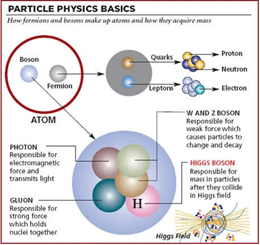TAG: GS-3 SCIENCE AND TECHNOLOGY
THE CONTEXT: CERN’s proposal to build a 90-kilometer-long particle accelerator, the Future Circular Collider (FCC), is primarily driven by the need to deepen our understanding of the Higgs boson. CERN’s 70th-anniversary celebration in 2024 may be its greatest achievement.
EXPLANATION:
About the Higgs Boson
The Higgs boson is the fundamental force-carrying particle of the Higgs field, which is responsible for granting fundamental particles their mass.
- It is the fundamental particle associated with the Higgs field, a field that gives mass to other fundamental particles such as electrons and quarks.
- This field was first proposed in the mid-sixties by Peter Higgs, for whom the particle is named.
- The particle was finally discovered on July 4, 2012, by researchers at the Large Hadron Collider (LHC), the most powerful particle accelerator in the world, located at the European particle physics laboratory CERN, Switzerland.
- The LHC confirmed the existence of the Higgs field and the mechanism that gives rise to mass and thus completed the standard model of particle physics.
- It is one of the 17 elementary particles that make up the Standard Model of particle physics, which is scientists’ best theory about the behaviours of the universe’s most basic building blocks.
- Higgs boson plays such a fundamental role in subatomic physics that it is sometimes referred to as the “God particle.”

Features:
-
- The Higgs boson has a mass of 125 billion electron volts, meaning it is 130 times more massive than a proton.
- It is also chargeless with zero spin, a quantum mechanical equivalent to angular momentum.
- It is the only elementary particle with no spin.
What is a Boson?
- A boson is a “force carrier” particle that comes into play when particles interact with each other, with a boson exchanged during this interaction.
- For example, when two electrons interact, they exchange a photon the force-carrying particle of electromagnetic fields.
Because quantum field theory describes the microscopic world and the quantum fields that fill the universe with wave mechanics, a boson can also be described as a wave in a field.
-
- So, a photon is a particle and a wave that arises from an excited electromagnetic field, and the Higgs boson is the particle or “quantized manifestation” that arises from the Higgs field when excited.
- That field generates mass via its interaction with other particles, and the mechanism carried by the Higgs boson called the Brout-Englert-Higgs mechanism.
- Particles that interact — or “couple” — with the Higgs field more strongly are granted greater masses.
- Even the Higgs boson itself gets its massfrom its own interaction with the Higgs field.
- One particle not granted massby the Higgs fieldis the basic particle of light, the photon. This is because spontaneous symmetry breaking doesn’t happen for photons as it does for its fellow force-carrying particles.
Source:
Spread the Word
